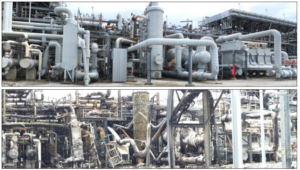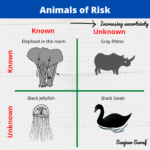Biofuel production and manufacturing facilities in the United States are increasing rapidly. On August 8, 2005, President Bush signed the Energy Policy Act of 2005 (H.R. 6) into law. The comprehensive energy legislation includes a nationwide renewable fuels standard (RFS) that will double the use of ethanol and biodiesel by 2012.
Biodiesel Incidents
Biodiesel popularity stems from the fact that it is simple to manufacture and essentially free of sulfur and aromatics. Biodiesel can be easily mixed with regular diesel and used for running automobiles. Although biodiesel is non-flammable and non-reactive, manufacturing of biodiesel poses processing hazards and careful attention should be paid to manufacture biodiesel safely as indicated by the following accidents.
- Feb. 2006: A fire at American Biofuel’s Biodiesel plant in Bakersfield, California resulted destroyed the entire plant. The fire was caused by a methanol spill possibly ignited by static electricity.
- 2005: A man repairing glycerin storage tank in a biodiesel facility in Staten Island died due to an explosion.
- June 2006: Fire destroys a biodiesel plant in Canby
Please note the above list is not comprehensive collection of biodiesel incidents.
Bioethanol Incidents
Over 90 percent of U.S. ethanol is made from corn. Active research is being conducted to manufacture ethanol from cellulose feedstock – agricultural waste, plant residue, municipal solid waste. Below are a few incidents involving bioethanol:
- June 15th, 2006, Shively, KY: Two Workers Treated For Burns After Fire At Shively Ethanol Plant
- September 22nd, 2005, West Burlington, IA: A grain dryer was the cause of a fire in an ethanol plant.
- September 5th, 2005, Brentwood, CA: Two thousand gallons of ethanol spilled onto a roadway and into a storm drain when a tanker truck overturned.
Please note the above list is not comprehensive collection of bio-ethanol incidents.
I have another post which has Google Maps of Biodiesel and Ethanol Incidents.
Safety Considerations
Both biodiesel and bioethanol facilities have flammable hydrocarbons especially highly flammable alcohol.
Methanol, ethanol, isopropanol are classified as Class IB flammable liquids according to OSHA 1910.106. Class IB substances have flash points below 73 F/22.8 C, boiling point higher than 100 F/37.8 C and can readily catch fire at room temperature. Therefore, special care should be taken while handling flammables in a biofuel production unit. In addition, methanol also poses toxic hazards.
The prevailing consensus amongst independent biofuel manufacturers is that process safety can be achieved by common sense and enforcement of prescriptive codes and standards; however, considerable expertise is needed to comprehensively mitigate biofuel manufacturing risks.
It is recommended that the biofuel manufacturers voluntarily adapt PSM in order to increase the safety of biodiesel production. Process Safety Management (PSM) has been successfully adopted by the chemical industries and refineries in the United States.
Note: Biofuel production facilities that use over 10,000 pounds (~1500 gallons) of alcohol or flammable mixtures are covered by the OSHA PSM rule (29 CFR 1910.119).
PSM can not only assist biofuel industry in the prevention of catastrophic events, it can also enhance employee knowledge of operations, improve technical procedures, maintain accurate process safety information, and increase overall facility productivity. In addition, manufacturing industries follow Recognized and Generally Accepted Good Engineering Practices (RAGAGEP) to improve safety and reduce incidents. Since most of the current biofuel manufacturers are small operations, set of guidelines encompassing PSM elements but less rigorous can be developed for such facilities. At first glance the documentation requirements of OSHA PSM seem daunting; however, a guideline document to ensure compliance with OSHA PSM without consuming too many resources can be developed.
Final Thought
To maintain a positive image, biofuels manufactures should give a serious thought to plant safety either by implementing “PSM-like” approach or by developing independent safety evaluation protocol.






7 Responses
My complements on a well written article, Dr. Saraf. I would like to take a copy to our biodiesel customers to encourage them to take the hazards mentioned in your article seriously.
I would like to prevent incidents as you recommended to biofuels manufacturers by adopting PSM like programs and procedures.
I commend your effort on calling for PSM or equivalent safety reviews for the bioethanol industry. I have been working with clients who are new to the chemical industry and decide to build a bioethanol plant.
When I brought safety concerns to the client’s attention, they were nonconmittal on preforming a safety review. The client figured this was similar to a brewery or grain distillery so he did not need to do this review.
I provided a fairly quick review of the last 3 years in the bioethanol industry (similar to your list) to the client along with pictures of the destruction. After that the client felt better about doing a PSM safety review but still did not take action items seriously.
Since the second generation bioethanol industry is getting big media play, I hope that the safety aspect will also become better known to the industry.
thanks for your informative article.
Great post and responses. Dr. Saraf, this is a brief but well thought out and researched post on bio fuels risks and safety. PSM is the place to start. And if not done voluntarily, OSHA will be there to inspect and levy heavy fines for failure to provide a safe working environment. Just because there is no current PSM for Bio fuel, does not mean there are no best engineering practices to adhere to. One of the NFPA standards most responsive to the changing environmental climate, NFPA 30, Flammable and Combustible Liquids Code , is looking at major evolution in light of the strong push for green manufacturing operations and the increased interest in bio-fuels. The 2008 edition of NFPA 30 sets the stage for these developments and is one of the first standards to be reorganized according to the NFPA hazmat template. I relate to Melinda’s post as I have experienced the same attitude in some of the solid bio fuel plants.
Dr. Saraf – Here is a tool and it’s free
FREE ON-LINE TRAINING – Process Safety Management for the Biofuels Industry from the Center for Chemical Process Safety at http://aiche.learn.com.
Process Safety Management for the Biofuel Industry, was developed by the Center for Chemical Process Safety (CCPS), a Technology Alliance of the American Institute of Chemical Engineers under a “Susan Harwood Grant” from the Occupational Safety & Health Administration (OSHA).
CCPS has designed the course from the ground up specifically for the Biofuel industries. Attendees will learn about Process Safety Management (PSM), how to implement a PSM program and the benefits that derive from implementing one. It is intended for companies and individuals covered by the Occupation Safety and Health Act.